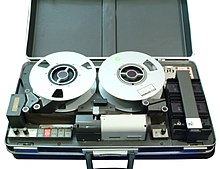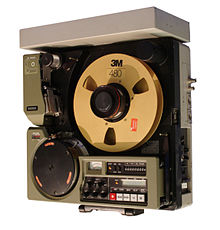Video tape recorder: Difference between revisions
Tag: section blanking |
|||
| Line 20: | Line 20: | ||
The development of the videocassette followed the replacement by cassette of other open-reel systems in consumer items: the [[Stereo-Pak]] 4-track audio cartridge in 1962, the [[compact audio cassette]] and [[Instamatic]] film cartridge in 1963, the [[Stereo 8|8-track cartridge]] in 1965, and the [[Super 8 mm film|Super 8]] home movie cartridge in 1966. |
The development of the videocassette followed the replacement by cassette of other open-reel systems in consumer items: the [[Stereo-Pak]] 4-track audio cartridge in 1962, the [[compact audio cassette]] and [[Instamatic]] film cartridge in 1963, the [[Stereo 8|8-track cartridge]] in 1965, and the [[Super 8 mm film|Super 8]] home movie cartridge in 1966. |
||
Before the invention of the video tape recorder, live video was recorded onto motion picture [[film stock]] in a process known as [[telerecording]]. Although the first Quadruplex VTRs recorded with good quality, the recordings could not be slowed or [[freeze frame]]d, so telerecording processes continued to be used for about a decade after the development of the first VTRs. |
Before the invention of the video tape recorder, live video was recorded onto motion picture [[film stock]] in a process known as [[telerecording]]. Although the first Quadruplex VTRs recorded with good quality, the recordings could not be slowed or [[freeze frame]]d, so telerecording processes continued to be used for about a decade after the development of the first VTRs. |
||
==Technology== |
|||
A audio video recorder uses [[recording head|heads]] on a spinning drum to read and write diagonal tracks onto a moving tape. This has many potential sources of timing errors. If the mechanism ran at an absolutely constant speed, and never varied from moment to moment, or from the time of recording to the time of playback, then the timing of the playback signal would be exactly the same as the input. However, imperfection being inevitable, the timing of the playback always differs to some extent from the original signal. Longitudinal error (error arising from effects in the long direction of the tape) can be caused by variations in the rotational rate of the [[Capstan (tape recorder)|capstan]] drive, stretching of the tape medium, and jamming of tape in the machine. Transverse error (error arising from effects in the cross-tape direction) can be caused by variations in the rotational speed of the scanning drum and differences in the angle between the tape and the scanning heads (usually addressed by video "[[video tape tracking|tracking]]" controls). Longitudinal errors are similar to the ones that cause [[wow (recording)|wow]] and [[Flutter (electronics and communication)|flutter]] in audio recordings. Since these errors are not so subtle and since it is standard video recording practice to record a parallel control track, these errors are detected and [[servos]] are adjusted accordingly to dramatically reduce this problem. |
|||
== VCR == |
== VCR == |
||
Revision as of 12:12, 18 July 2013
This article needs additional citations for verification. (May 2010) |



A video tape recorder (VTR) is a tape recorder designed to record video material, usually on magnetic tape. VTRs originated as individual tape reels, serving as a replacement for motion picture film stock and making recording for television applications cheaper and quicker. An improved form included the tape within a videocassette, which was used with Videocassette recorders (VCR). VCRs soon found their way onto the consumer market; however, there have been a wide variety of VTR technologies, many produced primarily for the professional.
History
The history of the videocassette recorder follows the history of videotape recording in general. In 1952 the Vision Electronic Recording Apparatus high speed multi-track machine was built and trialed by the BBC.[1] This machine used a thin steel tape on a 21-inch (53.5 cm) reel traveling at over 200 inches (510 cm) per second. Despite 10 years of research and improvements, the machine became obsolete when Ampex introduced the Ampex VRX-1000. This model became the world's first commercially successful videotape recorder in 1956. It used the 2" Quadruplex format, using two-inch (5.1 cm) tape.[2] Because of its US$50,000 price, the Ampex VRX-1000 could be afforded only by the television networks and the largest individual stations.[3]
In 1963, Philips introduced its EL3400 1" helical scan recorder (aimed at the business and domestic user) and Sony marketed the 2" PV-100, its first reel-to-reel VTR intended for business, medical, airline and educational use.[4]
The Telcan, produced by the Nottingham Electronic Valve Company and demonstrated on June 24, 1963[5], was the first home video recorder. It could be bought as a unit or in kit form for £60. However, there were several drawbacks: it was expensive, not easy to put together, and could record only 20 minutes' output at a time in black and white.[6][7][8]
The Sony model CV-2000, first marketed in 1965, was its first VTR intended for home use and was based on half-inch tape.[9] Ampex and RCA followed in 1965 with its own reel-to-reel monochrome VTRs priced under US $1,000 for the home consumer market.
The EIAJ format was a standard half-inch format used by various manufacturers. EIAJ-1 was an open-reel format. EIAJ-2 used a cartridge that contained a supply reel, but not the take-up reel. Since the take-up reel was part of the recorder, the tape had to be fully rewound before removing the cartridge, a slow procedure.
The development of the videocassette followed the replacement by cassette of other open-reel systems in consumer items: the Stereo-Pak 4-track audio cartridge in 1962, the compact audio cassette and Instamatic film cartridge in 1963, the 8-track cartridge in 1965, and the Super 8 home movie cartridge in 1966. Before the invention of the video tape recorder, live video was recorded onto motion picture film stock in a process known as telerecording. Although the first Quadruplex VTRs recorded with good quality, the recordings could not be slowed or freeze framed, so telerecording processes continued to be used for about a decade after the development of the first VTRs.
VCR
Many of the deficiencies of the reel-to-reel systems were overcome with the invention of the Video cassette recorder (VCR), where the videotape is enclosed in a user-friendly videocassette shell. This subsequently became the most familiar type of VTR known to consumers. In this system, the tape is pre-attached onto two reels enclosed within the cassette, and tape loading and unloading is automated. There is no need for the user to ever touch the tape, and the media can be protected from dust, dirt, and tape misalignments that could foul the recording mechanism. Typically, the only time the user ever touches the tape in a videocassette is when a failure results from a tape getting stuck in the mechanism.
Home VCRs first became available in the early 1970s, with Philips releasing the Model 1500 in England in 1972.[10] It, for the first time, offered users the capability of deciding what they wanted to watch. The first system to be successful with consumers was Sony's Betamax (or Beta) in 1975. It was soon followed by the competing VHS (Video Home System) format from JVC in 1977 [10] and later by other formats such as Video 2000 from Philips, V-Cord from Sanyo, and Great Time Machine from Quasar.
The Beta–VHS format war soon began, while the other competitors quickly disappeared. Betamax sales eventually began to dwindle, and after several years VHS emerged as the winner of the format war. In 1988, Sony began to market its own VHS machines, and despite claims that it was still backing Beta, it was clear that the format was no longer viable in most parts of the world. In parts of South America and in Japan, Betamax continued to be popular and was still in production up to the end of 2002.[citation needed]
Later developments saw magnetic tapes largely replaced by digital video tape formats. Following this, much of the VTR market, in particular videocassettes and VCRs popular at the consumer level, were also replaced by digital media, such as DVD and later Blu-ray optical discs.
Formats and products
Video tape recorder technologies include:
- Analog reel-to-reel
- 1" Type A (Ampex)
- 1" Type B (Bosch's Fernseh - BTS Philips)
- 1" Type C (Sony, Ampex, NEC and Hitachi)
- 2" Quadruplex (Ampex, RCA and Bosch's Fernseh)
- Ampex 2 inch helical VTR
- IVC 2 inch Helical scan (International Video Corporation's IVC 9000 Format)
- VERA (BBC)

- Professional cassette and cartridge based systems
- Standard definition digital videotape formats
- D1 (Sony) and Broadcast Television Systems Inc.
- D2 (Sony and Ampex)
- D3 (Panasonic)
- D5 (Panasonic)
- D9 (Digital-S) (JVC)
- Betacam IMX (Sony)
- DCT (Ampex)
- Digital Betacam (Sony)
- DVCAM (Sony)
- DVCPRO (Panasonic)

- High definition digital video tape formats
- D5 HD (Panasonic)
- D6 HDTV VTR (BTS - Philips - Thomson SA - Grass Valley (company))
- DVCPROHD (Panasonic)
- D-VHS (JVC and Panasonic)
- HD
- HDCAM (Sony)
- HDCAM-SR (Sony)
- Consumer format
- Betamax
- Cartrivision
- Digital8 (Sony)
- DV (miniDV is the cassette size)
- EIAJ Half inch open reel and cassette[11]
- Hi8
- MicroMV
- S-VHS (JVC)
- Video8
- Video 2000 (Philips)
- VHS
- VHS-C (JVC)
- VX (videocassette format)
Cultural impact
The Buggles' hit song "Video Killed the Radio Star", the first video ever to air on MTV, contains the lyric "Put the blame on VTR".[12]
See also
References
- ^ "The History of Magnetic Recording". BBC 20 December 2004. Retrieved 15 March 2011.
- ^ "Ampex VRX-1000 - The first commercial videotape recorder in 1956". Cedmagic.com. 1956-04-14. Retrieved 2010-05-31.
- ^ Richard N. Diehl. "Labguy'S World: The Birth Of Video Recording". Labguysworld.com. Retrieved 2010-05-31.
- ^ "Sony Global - Sony History". Sony.net. Retrieved 2010-05-31. [dead link]
- ^ Albert Abramson, The History of Television, 1942 to 2000 (McFarland, 2003) p99
- ^ "The quest for home video: Telcan home video recorder". Terramedia.co.uk. 2001-10-22. Retrieved 2010-05-31.
- ^ "Total Rewind". Total Rewind. Retrieved 2010-05-31.
- ^ "BBC History". Bbc.co.uk. 1963-06-24. Retrieved 2010-05-31.
- ^ "Sony CV Series Video". Smecc.org. Retrieved 2010-05-31.
- ^ a b "VCR and Home Video History". Television History - The First 75 Years. TVhistory.TV. Retrieved 24 May 2011.
- ^ 1965 - Sony releases first home video equipment
- ^ Lyrics to "Video Killed the Radio Star"
